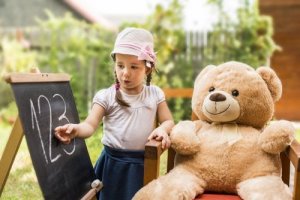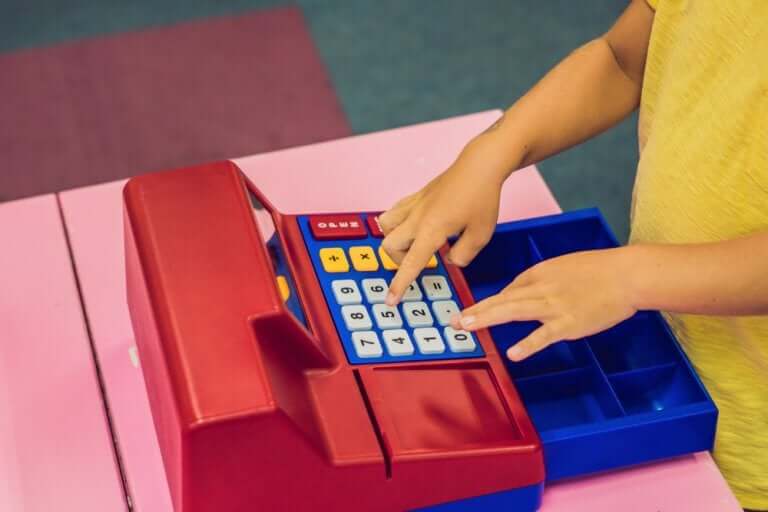Role-Playing with Children: How to Do It

Role-playing with children is one of the simplest and most rewarding activities you can do with them. It’s something totally natural for them to do, even from a very young age. From a very early age, children begin to act out situations in their games in an unconscious way.
We often think that children are just playing when they pretend to be pirates, fairies, superheroes, elves, or when they create their own characters using dolls or Lego figures. But, in addition to this, and most importantly of all, they’re using their imagination and creating role-playing situations in a natural way.
This role-playing and acting that seem so simple, are, in fact, quite complex creations that they perform naturally. They’re also very beneficial for their development. Let’s see why role-playing is so positive for children and some ways in which it can be practiced.
Reasons why role-playing is good for children
- It encourages creativity. The power of a child’s imagination is a wonderful thing to watch. All they need is a little time, space, and encouragement. They can become anything and go anywhere just by role-playing.
- They invent stories and adventures and create whole new worlds, dialogues, and actions naturally. The amazing thing is that they don’t even need to think about it. Children have the purest form of creativity.
- Role-playing with children allows them to reflect what they experience in the world around them and to recreate their social relationships through play. Children make sense of the world and imitate the social interactions they find around them. They do this through imaginative play with friends, siblings, parents, and even stuffed animals.

- Children can have an adventure with a teddy bear, and become their doctor, or even share a snack with them. Not only is it really adorable, but it’s a great way for children to practice the interpersonal skills and dynamics that they’re learning.
- Role-playing with children encourages cooperation and conflict resolution. If two children want to be the same character in a game, they have to resolve the conflict. They may, for example, decide to take turns with the character.
Activities for role-playing with children
Let’s look at some basic role-playing activities that we can do with children, both in the classroom and at home. We can encourage our children to play with others, or we can also be their guides.
Improvisations with two characters
If you have a small group of children, one thing that works very well is to do some simple improvisations with two characters. Two children will improvise and the others will observe and comment. They’ll take turns, two by two, until everyone has done their role-play.
The two characters will have a role. One of them will be the main character, and the other will be the supporting actor. The main character needs to ask the other character for something.
The task of the other character is then to deny the main character what they want, and try to prevent them from getting it. In this way they both learn different useful strategies:
- Learning to discuss things in a natural way
- Putting themselves in the partner’s place. They develop empathy, and enhance their creativity by inventing a character.
- Making a real effort to achieve something
In this role-play situation, nobody wins and nobody loses. It’s a game where both parties win and they work towards an objective that they achieve as the activity develops.
Group improvisations
Here, you split the children into different groups, and they’ll create a mini role-play using only one title as a guide. As teachers or parents, we’ll give them a title and they’ll develop a little drama sketch using that title. We can give them some time to decide how they’re going to do it, and then ask them to act out the role-play.
Not only will they have fun, but they’ll also learn how to work in a group, to share the work, and to make decisions. They’ll choose their own characters (decision-making) and look for a common ending. The idea is to act out the dramatization in front of a small group of people (other classmates or parents). Either that, or they can simply play for the sake of playing.

Songs and ideas
Here we choose a song which we think has a nice message, or that the children know and like. We all listen to that song together and then carry out a little play based on it. The children will choose each of the characters.
The time that you’ll spend on it will depend on what you want to work on and the objectives that you have for the children. If you’re looking for a quick activity, then you can do the role-play just once. In this way, you can just have fun and enjoy the whole process.
However, if you’re looking for specific objectives, such as developing an idea and letting them focus on it, then you can dedicate more time to it. Little by little, lots of ideas will emerge and the group can have good discussions about the role-play before acting it out.
The idea of encouraging children to perform role-plays at home or in the classroom is always a positive one. Including these role-plays in a child’s education brings great results and, above all, a lot of fun.
Role-playing with children is one of the simplest and most rewarding activities you can do with them. It’s something totally natural for them to do, even from a very young age. From a very early age, children begin to act out situations in their games in an unconscious way.
We often think that children are just playing when they pretend to be pirates, fairies, superheroes, elves, or when they create their own characters using dolls or Lego figures. But, in addition to this, and most importantly of all, they’re using their imagination and creating role-playing situations in a natural way.
This role-playing and acting that seem so simple, are, in fact, quite complex creations that they perform naturally. They’re also very beneficial for their development. Let’s see why role-playing is so positive for children and some ways in which it can be practiced.
Reasons why role-playing is good for children
- It encourages creativity. The power of a child’s imagination is a wonderful thing to watch. All they need is a little time, space, and encouragement. They can become anything and go anywhere just by role-playing.
- They invent stories and adventures and create whole new worlds, dialogues, and actions naturally. The amazing thing is that they don’t even need to think about it. Children have the purest form of creativity.
- Role-playing with children allows them to reflect what they experience in the world around them and to recreate their social relationships through play. Children make sense of the world and imitate the social interactions they find around them. They do this through imaginative play with friends, siblings, parents, and even stuffed animals.

- Children can have an adventure with a teddy bear, and become their doctor, or even share a snack with them. Not only is it really adorable, but it’s a great way for children to practice the interpersonal skills and dynamics that they’re learning.
- Role-playing with children encourages cooperation and conflict resolution. If two children want to be the same character in a game, they have to resolve the conflict. They may, for example, decide to take turns with the character.
Activities for role-playing with children
Let’s look at some basic role-playing activities that we can do with children, both in the classroom and at home. We can encourage our children to play with others, or we can also be their guides.
Improvisations with two characters
If you have a small group of children, one thing that works very well is to do some simple improvisations with two characters. Two children will improvise and the others will observe and comment. They’ll take turns, two by two, until everyone has done their role-play.
The two characters will have a role. One of them will be the main character, and the other will be the supporting actor. The main character needs to ask the other character for something.
The task of the other character is then to deny the main character what they want, and try to prevent them from getting it. In this way they both learn different useful strategies:
- Learning to discuss things in a natural way
- Putting themselves in the partner’s place. They develop empathy, and enhance their creativity by inventing a character.
- Making a real effort to achieve something
In this role-play situation, nobody wins and nobody loses. It’s a game where both parties win and they work towards an objective that they achieve as the activity develops.
Group improvisations
Here, you split the children into different groups, and they’ll create a mini role-play using only one title as a guide. As teachers or parents, we’ll give them a title and they’ll develop a little drama sketch using that title. We can give them some time to decide how they’re going to do it, and then ask them to act out the role-play.
Not only will they have fun, but they’ll also learn how to work in a group, to share the work, and to make decisions. They’ll choose their own characters (decision-making) and look for a common ending. The idea is to act out the dramatization in front of a small group of people (other classmates or parents). Either that, or they can simply play for the sake of playing.

Songs and ideas
Here we choose a song which we think has a nice message, or that the children know and like. We all listen to that song together and then carry out a little play based on it. The children will choose each of the characters.
The time that you’ll spend on it will depend on what you want to work on and the objectives that you have for the children. If you’re looking for a quick activity, then you can do the role-play just once. In this way, you can just have fun and enjoy the whole process.
However, if you’re looking for specific objectives, such as developing an idea and letting them focus on it, then you can dedicate more time to it. Little by little, lots of ideas will emerge and the group can have good discussions about the role-play before acting it out.
The idea of encouraging children to perform role-plays at home or in the classroom is always a positive one. Including these role-plays in a child’s education brings great results and, above all, a lot of fun.
All cited sources were thoroughly reviewed by our team to ensure their quality, reliability, currency, and validity. The bibliography of this article was considered reliable and of academic or scientific accuracy.
- Daste C.; Jenger, Y. y Voluzan, J. (1978). El niño, el teatro y la escuela. Madrid: Villalar.
- Eines, J. y Mantovani, A. (1997). Didáctica de la Dramatización. Barcelona: Gedisa.
- Navarro Solano, M. (2007). Drama, creatividad y aprendizaje vivencial: algunas aportaciones del drama a la educación emocional. Cuestiones pedagógicas, 18, 163-174. https://idus.us.es/xmlui/bitstream/handle/11441/12845/file_1.pdf?sequence=1
- Núñez Cubero, L. y Romero, C. (2004). La educación emocional a través del lenguaje dramático. Addenda a la II Ponencia: Los lenguajes de las Artes. Escenas y Escenarios en Educación, XXII-Site-Sitges Conference.
- Núñez Cubero, L.; Bisquerra Alzina, R.; González Monteagudo, J. y Gutiérrez Moar, M.C.(2006). Emociones y educación: una perspectiva pedagógica. En J.M. Asensio; J. Carrasco García; L. Núñez Cubero y J. Larrosa (Coords.) La vida emocional. Las emociones y la formación de la identidad humana (171-196). Barcelona: Ariel.
- Tejerina, I. (1994). Dramatización y teatro infantil. Dimensiones psicopedagógicas y expresivas. Madrid: Siglo XXI.
- Vieites, M. F. (2017). La Pedagogía Teatral como Ciencia de la Educación Teatral. (UVIGO). Universidad de Vigo. Pontevedra. España. Revista Educaçao & Realidade, Porto Alegre 42 (4): 1421-1544. Recuperado de http://www.scielo.br/pdf/edreal/v42n4/2175-6236-edreal-62918.pdf
- Laferriere, G. (1999). 11 La pedagogía teatral, una herramienta para educar. Educación social, 1, 55. Recuperado de https://core.ac.uk/download/pdf/39108274.pdf
This text is provided for informational purposes only and does not replace consultation with a professional. If in doubt, consult your specialist.








